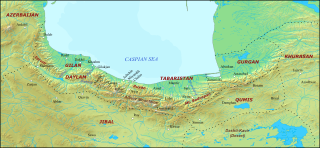
Wilferd Ferdinand Madelung FBA is a German-British author and scholar of Islamic history.

Abu Kalijar Marzuban, also known as Samsam al-Dawla was the Buyid amir of Iraq (983–987), as well as Fars and Kerman. He was the second son of 'Adud al-Dawla. The Abbasids recognized his succession and conferred upon him the title Samsam al-Dawla. He lacked the qualities of his father 'Adud al-Dawla and failed to have a grip upon his state affairs. His rule was marked by revolts and civil wars.
Zahir al-Dawla Vushmgir, mostly known as Vushmgir, was the second Ziyarid emir who ruled from 935 until his death in December 967. He was a son of Ziyar. Voshmgir means "quail catcher" in the local Caspian Iranian dialects.

Mardavij was an Iranian prince, who established the Ziyarid dynasty, ruling from 930 to 935.
Muhammad bin Musafir was the Sallarid ruler of Tarum in modern northwest Iran and Iranian Azerbaijan (949). He was the son of Musafir, and his original name seems to have been Sallar or Salar ; 'Sallar' would later become a title used by his successors.

Daysam ibn Ibrahim al-Kurdi was a Kurdish commander who occasionally ruled Adharbayjan between 938 and 955 during the power struggle that ensured after the fall of the Sajid dynasty.

Tabaristan or Tabarestan, was the name applied to a mountainous region located on the Caspian coast of northern Iran. It corresponded to the present-day province of Mazandaran, which became the predominant name of the area from the 11th-century onwards.
The Daylamites or Dailamites were an Iranian people inhabiting the Daylam—the mountainous regions of northern Iran on the southwest coast of the Caspian Sea, now comprising the southeastern half of Gilan Province.

Muhammad III was the third Layzanshah and the seventh Shirvanshah. He was the son of Abu Tahir Yazid.
Qarin I, was the eighth ruler of the Bavand dynasty from 839 to 867.
Ka'us III, was the fourth ruler of the Paduspanid branch of Kojur. He was the son and successor of Ashraf ibn Taj al-Dawla.
Tirdadh was the first king of the Gilites, ruling during an unknown date between the 9th and 10th-century. He was succeeded by Lili ibn al-Nu'man. Tirdadh had a son named Harusindan, who would later succeed Lili ibn al-Nu'man as the new ruler of the Gilites.
Lili ibn al-Nu'man, also known as Lili ibn Shahdust, was the leader of the Shahanshahvand clan, and also ruled as the second king of the Gilites, ruling from the early 10th-century to 921. He served in high offices under his overlord the Zaydids. In 921, he invaded the territories of Samanids, conquering Damghan, Nishapur and Merv. He was, however, defeated and killed by a Samanid army under Abu'l-Fadl al-Bal'ami and Simjur al-Dawati. Lili was succeeded by Harusindan, who was a Gilite from another clan.
This is a family tree of the Bavandid rulers, and their ancestors.

The Qarinvand dynasty, or simply the Karenids, was an Iranian dynasty that ruled in parts of Tabaristan (Mazandaran) in what is now northern Iran from the 550s until the 11th-century. They considered themselves as the inheritors of the Dabuyid dynasty, and were known by their titles of Gilgilan and Ispahbadh. They were descended from Sukhra, a Parthian nobleman from the House of Karen, who was the de facto ruler of the Sasanian Empire from 484 to 493.
Harusindan was the third king of the Gilites, ruling briefly in 921. He was the son of Tirdadh, who was the first king of the Gilites during the 10th century, but later died and was succeeded by another Gilite named Lili ibn al-Nu'man, who was from another clan. Harusindan also had a sister who married a Dailamite nobleman named Ziyar, and together they had a son named Mardavij, who would later create the Ziyarid dynasty.
Justan III was the sixth king of the Justanid dynasty, ruling from 865 to 919. He was the brother and successor of Khurshid of Dailam.
Shahanshahvand was the name of a royal Gilite clan roaming in Dakhel, Iran. A member of the clan, Lili ibn al-Nu'man, ruled as the King of the Gilites in the early 10th-century until he was killed in 921 in a battle with the Samanids.
Farawand was the name of a royal Daylamite clan roaming in Dakhel, Iran. A member of the clan, Khushkiya ibn Wijka, ruled as King of the Gilites in the early 10th-century.

Ruyan, later known as Rustamdar (رستمدار), was the name of a mountainous district that encompassed the western part of Tabaristan/Mazandaran, a region on the Caspian coast of northern Iran.






